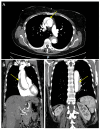Early Diagnosis of an Atypical Type A Aortic Dissection With Point-of-Care Ultrasound: A Case Report
- PMID: 39323669
- PMCID: PMC11422784
- DOI: 10.7759/cureus.67780
Early Diagnosis of an Atypical Type A Aortic Dissection With Point-of-Care Ultrasound: A Case Report
Abstract
Aortic dissection is a rare but potentially fatal condition, characterized by a high mortality rate where every minute of delay in treatment counts. Its diagnosis remains challenging due to its often atypical clinical presentation. This case report presents an atypical case of type A aortic dissection in a 75-year-old female patient, highlighting the importance of early diagnosis facilitated by point-of-care ultrasound and emphasizing the value of its use in suspected aortic dissection regardless of the clinical probability. Additionally, this report reviews the risk factors for misdiagnosis and underscores the utility of diagnostic scores such as the aortic dissection detection risk score.
Keywords: aortic dissection; aortic dissection detection risk score (add-rs); emergency medicine; pocus; point-of-care ultrasound; type a aortic dissection.
Copyright © 2024, Rodrigues de Castro et al.
Conflict of interest statement
Human subjects: Consent was obtained or waived by all participants in this study. Conflicts of interest: In compliance with the ICMJE uniform disclosure form, all authors declare the following: Payment/services info: All authors have declared that no financial support was received from any organization for the submitted work. Financial relationships: All authors have declared that they have no financial relationships at present or within the previous three years with any organizations that might have an interest in the submitted work. Other relationships: All authors have declared that there are no other relationships or activities that could appear to have influenced the submitted work.
Figures



Similar articles
-
Atypical Presentation of Aortic Dissection in a Young Female and the Utility of Point-of-Care Ultrasound in Identifying Aortic Dissection in the Emergency Department.Cureus. 2022 Jul 25;14(7):e27236. doi: 10.7759/cureus.27236. eCollection 2022 Jul. Cureus. 2022. PMID: 36035033 Free PMC article.
-
Aortic Dissection Masquerading as Pneumonia: A Case Report of an Atypical Presentation.Cureus. 2024 Aug 1;16(8):e65930. doi: 10.7759/cureus.65930. eCollection 2024 Aug. Cureus. 2024. PMID: 39221396 Free PMC article.
-
Type A aortic dissection mimicking saddle pulmonary embolism on CT imaging.J Am Coll Emerg Physicians Open. 2020 Mar 5;1(2):132-136. doi: 10.1002/emp2.12026. eCollection 2020 Apr. J Am Coll Emerg Physicians Open. 2020. PMID: 33000025 Free PMC article.
-
Ultrasound of the Aorta.Emerg Med Clin North Am. 2024 Nov;42(4):791-803. doi: 10.1016/j.emc.2024.05.005. Epub 2024 Aug 14. Emerg Med Clin North Am. 2024. PMID: 39326988 Review.
-
Use of aortic point-of-care ultrasound in conventional and emergent echocardiography.J Med Ultrason (2001). 2022 Oct;49(4):655-661. doi: 10.1007/s10396-021-01151-w. Epub 2021 Nov 12. J Med Ultrason (2001). 2022. PMID: 34767103 Review.
References
-
- A systematic review and meta-analysis of the incidence of acute aortic dissections in population-based studies. Gouveia E Melo R, Mourão M, Caldeira D, et al. J Vasc Surg. 2022;75:709–720. - PubMed
-
- Does this patient have an acute thoracic aortic dissection? Klompas M. JAMA. 2002;287:2262–2272. - PubMed
-
- Emergency physician focused cardiac ultrasound improves diagnosis of ascending aortic dissection. Pare JR, Liu R, Moore CL, Sherban T, Kelleher MS Jr, Thomas S, Taylor RA. Am J Emerg Med. 2016;34:486–492. - PubMed
-
- The International Registry of Acute Aortic Dissection (IRAD): new insights into an old disease. Hagan PG, Nienaber CA, Isselbacher EM, et al. JAMA. 2000;283:897–903. - PubMed
-
- Misdiagnosis of aortic dissection: a systematic review of the literature. Lovatt S, Wong CW, Schwarz K, et al. Am J Emerg Med. 2022;53:16–22. - PubMed
Publication types
LinkOut - more resources
Full Text Sources
